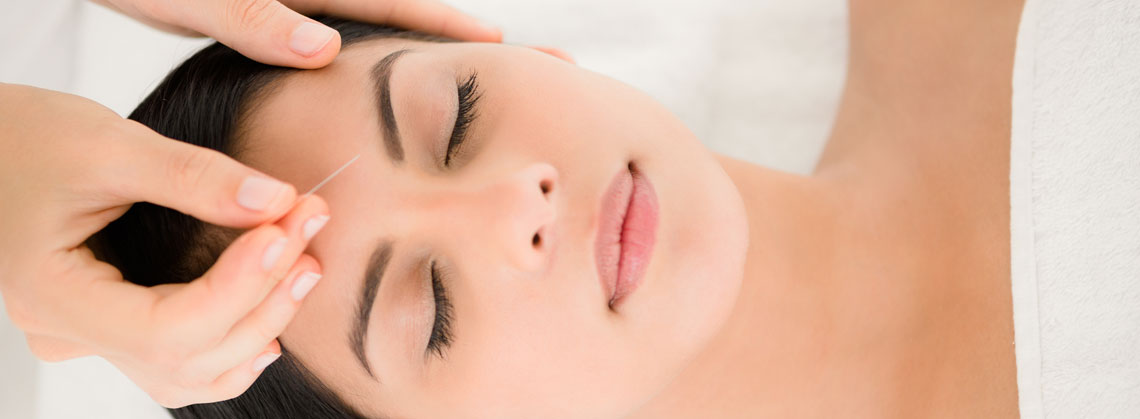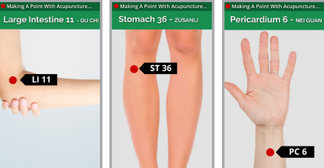Chinese Medicine is based on the concept of Qi. The ancient character of Qi looks like this 氣 and is composed of two parts: the lower one is 米 Mi meaning rice, and material, while the upper one is Qi 气 – air or gas, and shows vapours arising from the pot of boiling rice. There are many layers of meaning simultaneously shown by character Qi. It is something nourishing, and something which has material and non-material forms. It is impossible to translate this complex idea into any Western language without losing at least a part of meaning. The most popular translation of Qi is energy, while more appropriate is breath or vapour.
According to ancient books this Qi influences all functions of the body and is transported through the body by special conduits compared to channels build in China in order to control rivers and irrigate fields. What is interesting, those channels are described as functional, not material. They are said to exist between muscles, bones, and tissues not being muscles bones nor tissues.
Certainly this concept was not understood by Western scholars who went to China in the XVII century and later. Western science was built on materialism and reductionism, so ideas describing functions not forms couldn’t be accepted. When British scholar William Wotton saw the drawings explaining the routes of channels he falsely pre-assumed they were anatomic drawings and criticized Chinese Medicine for not being scientific.
The pH goes a hundred times more alkaline, which allows better oxygen uptake, and suppresses some harmful entities.
Beginning from that misunderstanding Western scholars have been still trying to find material, anatomical or histological structures helping them in explanation of extraordinary effectiveness of acupuncture, even when it’s applied to points located far away from the place of dysfunction . In fact they found many valuable clues and created few interesting theories concerning acupuncture points, channels, and transmission of acupuncture signal in the body.
- Electricity and neural pathways.
- Reflex reaction.
- Central reaction in brain.
- Mechanical signalling through connective tissue.
- Other theories.
ELECTRICITY AND NEURAL PATHWAYS
The scientific evaluation of acupuncture begun in the 1970s from studies concerning its influence on the feeling of pain. Pain is also the best researched indication for acupuncture and first attempts of describing the mechanisms of action of that method came from the field of neurology and pain management. In 1980s the model of acupuncture’s influence on nervous system was proposed. Since then the model has been developed and now it describes the neurological response to acupuncture stimulation on three levels:
Local reaction
When a needle penetrates the skin and is manipulated it causes local tissue injury and triggers the cascade of local biochemical reactions. Those reactions were summarized and discussed in an article published in 2012 in Evidence-Based Complementary and Alternative Medicine1
1. Tissue injury leads to impulse resulting local vasodilatation and release of vascular and neuroactive mediators from immune cells leaking from vessels.
2. Mast cells, platelets and other immune cells migrate to the place of injury. Together with damaged cells they release neuroactive mediators, like histamine, serotonin, substance P, acetylocholine, γ-aminobutyric acid, somatostatin, nitric oxide, adenosine, bradykinin, prostaglandins, cytokines and many others. Those substances infiltrate the tissues and act at corresponding receptors on the surface of afferent nerves.
The information about the fact of needling is carried to the Central Nervous System by afferent nerve fibres. Interestingly different stimulations activate different nerves. Most studies indicate that Aβ/δ-type afferents preferentially mediate electroacupuncture analgesia, whereas all types, particularly C-type afferents, preferentially mediate manual acupuncture analgesia2.
Reflex reaction
The acupuncture signal reaches the dorsal horns of spinal cord on specific level depending on nerves activated during insertion and stimulation of the needle. That signal triggers reflex reaction from the same or adjacent segment of the spinal cord affecting internal organs innervated by nerves from this part of spinal cord.
Except of causing reflex reaction, the signal is transmitted upwards to the brain. Neural acupuncture pathways are connected with pain pathways, ascending mainly through the ventrolateral funiculus.
Central reaction in brain
Many studies confirming the effectiveness of acupuncture and explaining its actions are focused on its influence on the activity of the brain. Past decades of research proved, that acupuncture stimulation results in specific and complex changes in functioning of various structures of the brain. Contrary to dugs, acting on single stage of specific process, acupuncture simultaneously regulates many processes ensuring proper action by influencing different stages of their development.
In 2013 very interesting article was published, describing effects of acupuncture on central autonomic regulation in different parts of the brain3
Hypothalamus
Hypothalamus is the most important centre of autonomic regulations, and acupuncture modulates its function:
- acupuncture regulates the expression of neuronal nitric oxide synthase in hypothalamus,
- acupuncture decreases neuropeptide Y production due to stimulation on the paraventricular nucleus in hypothalamus,
- arcuate nucleus connects with many other structures of the brain like periaqueductal grey in midbrain, rostral ventrolateral medulla (rVLM) and the nucleus of the solitary tract, and plays important role in mediating the influence of acupuncture on cardiovascular functions.
Medulla Oblongata
Acupuncture modulates neurons in rostral ventrolateral medulla (rVLM) resulting in inhibition of sympathoexcitatory cardiovascular responses. Opioids and GABA participate in long term acupuncture related inhibition. Serotonergic neurons from nucleus raphe pallidus (NRP) and 5-HT1A receptors in rVLM play role in cardiovascular responses to acupuncture. Nucleus ambiguous, an important site of origin of preganglionic parasympathetic vagal motor neurons, is also modulated by stimulation of specific acupuncture points.
Midbrain
Crucial role of ventrolateral periaqueductal gray (vlPAG) in processing acupuncture signals was described during studies researching the role of acupuncture in regulating blood pressure. Mutual connections between vlPAG and arcuate neurons in hypothalamus play important role in prolonging beneficial effects of acupuncture
Prefrontal Cortex
Acupuncture inhibits the activity of dorsomedial prefrontal cortex leading to decrease of sympathetic activity and increase of parasympathetic activity. This action is beneficial in treating chronic pain resulting from hyperactivity of sympathetic nervous system
Zhi-Qi Zhao from Fudan University presented detailed description of different neural mechanisms underlying acupuncture analgesia in the article published in 2008.
Neural mechanisms explaining the influence of acupuncture on blood pressure were described by Peng Li and John C Lonhurst in their article from 2010.
Mechanical signalling through connective tissue
Neurological studies proved that acupuncture signal is, at least partially, transmitted by the nervous system. Scientists have discovered many local and central effects of acupuncture on neurons and the functioning of the brain. However neural path may be not the only one. As a result of very interesting experiments a team led by prof Helene Langevin proposed complementary explanation6:
1. When a needle penetrates the skin and is stimulated by an acupuncturist it rotates.
2. Locally collagen fibres are wound around stimulated, rotating acupuncture needle.
3. Wound fibres are pulled resulting in deformation of extracellular collagen matrix
4. Cells like fibroblasts, endothelial cells, sensory neurons are connected with extracellular collagen matrix by focal adhesions. Deformation of collagen matrix triggers wide range of intracellular responses including changes in actin cytoskeleton with formation of stress fibres. 5. Cytoskeletal reorganization induces cell contraction, migration and protein synthesis
6. Described mechanical signal transduction potentially leads to various effects, including modification of surrounding extracellular matrix, autocrine and paracrine effects.
It was also shown that great majority of acupuncture points are located above aggregations of connective tissue.
Important role of mechanical signalling along connective tissue planes is confirmed by other experiments. When a collagen matrix is destroyed locally in acupuncture point by the injection of collagenase I, the beneficial effect of stimulation of this point is significantly diminished8.
Other theories
Models describing transmission of acupuncture signal through nerves and simultaneously along connective tissue planes are used to explain complex action of acupuncture. They are well researched and based on many experiments. However they are not the only ones.
Two Taiwanese scholars were authors of an interesting article published in 2008 and focusing on the role of nitric oxide in neurovascular transmission model9.
1. This model also starts from mechanical force resulting from by acupuncture needle inserted into tissues. This force is then transferred to extracellular matrix.
2. Through this matrix, the signal stimulates vascular nerve fibres triggering production of nitric oxide by neural and endothelial nitric oxide sythases. Nitric oxide influences vascular smooth muscles and changes local circulation.
3. Local mechanical stress caused by acupuncture together with cyclic strain of the vessel changes the frequency of resonance
4. Modulation of resonance leads to changes in blood distribution and microcirculation in various organs further affecting the production of nitric oxide by endothelial nitric oxide synthase. Other theories about the transmission of acupuncture signal involve its influence on electromagnetic fields, or postulate the role of small structures called “primo vessels”.
BIBLIOGRAPHY
1 Zhang ZJ, Wang XM, McAlonan GM. „Neural acupuncture unit: a new concept for interpreting effects and mechanisms of acupuncture. Evid Based Complement Alternat Med. 2012;2012:429412. doi: 10.1155/2012/429412. Epub 2012 Mar 8.
2 Zhao ZQ. „Neural mechanism underlying acupuncture analgesia.” Prog Neurobiol. 2008 Aug;85(4):355-75. doi: 10.1016/j.pneurobio.2008.05.004. Epub 2008 Jun 5
3 Li QQ, Shi GX, Xu Q, Wang J, Liu CZ, Wang LP „Acupuncture effect and central autonomic regulation”. Evid Based Complement Alternat Med. 2013;2013:267959. doi: 10.1155/2013/267959. Epub 2013 May 26.
4 Zhao ZQ. „Neural mechanism underlying acupuncture analgesia.” Prog Neurobiol. 2008 Aug;85(4):355-75. doi: 10.1016/j.pneurobio.2008.05.004. Epub 2008 Jun 5
5 Li P, Longhurst JC. „Neural mechanism of electroacupuncture’s hypotensive effects.” Auton Neurosci. 2010 Oct 28;157(1-2):24-30. doi: 10.1016/j.autneu.2010.03.015. Epub 2010 May 5.
6 Langevin HM, Churchill DL, Cipolla MJ. „Mechanical signaling through connective tissue: a mechanism for the therapeutic effect of acupuncture.” FASEB J. 2001 Oct;15(12):2275-82.
7 Helene M. Langevin et al. „Relationship of Acupuncture Points and Meridians to Connective Tissue Planes” The Anatomical Record (NEW ANAT.) 2002, 269:257–265,
8 Yu X, Ding G, Huang H, Lin J, Yao W, Zhan R: „Role of collagen fibres in acupuncture analgesia therapy in rats” Connet Tissue Res 2009; 50(2); 110-20
9 Hsiao SH, Tsai LJ. „A neurovascular transmission model for acupuncture-induced nitric oxide.” J Acupunct Meridian Stud. 2008 Sep;1(1):42-50. doi: 10.1016/S2005-2901(09)60006-6. Epub 2009 Mar 24.
ABOUT THE AUTHOR
Bartosz Chmielnicki MD has been practicing acupuncture for more than 10 years. Co-founder of center for natural therapies – Compleo, and Silesian Academy of Acupuncture. President of Silesian Chapter and Board member of Polish Acupunture Association (2007-2009), and a President of Classical Acupuncture Association (2010 – 2014).
Author of seminars on acupuncture for physicians organized by Colleguim Medicum of Jagiellonian University in Cracow. Provides courses in Czech Republic and Germany, lecturing in Poland, Czech Republic, Germany, Israel, including the largest meeting of Chinese Medicine Community in Rothenburg. Publishes articles, book chapters, educational posters, and a book about pulse diagnosis. Cooperates with dr Yair Maimon and Rani Ayal.
Cooperates with dr Yair Maimon and Rani Ayal.
author: Bartosz Chmielnicki M.D. (trans.: Urszula Torbus)




